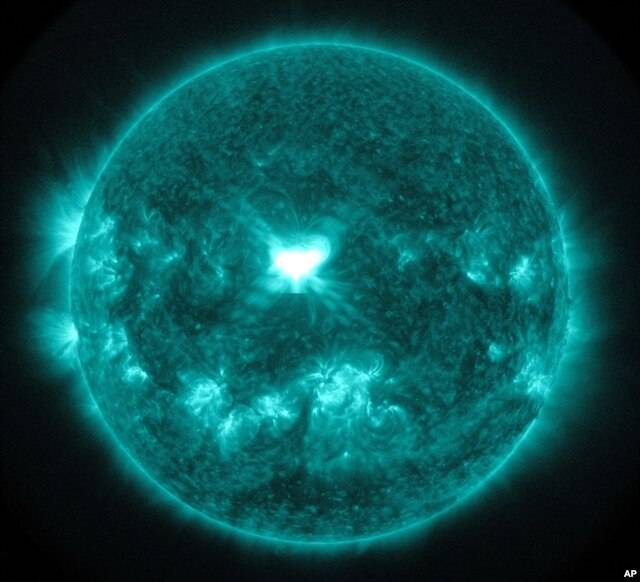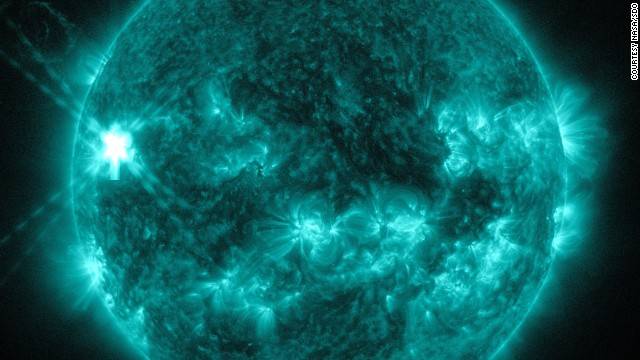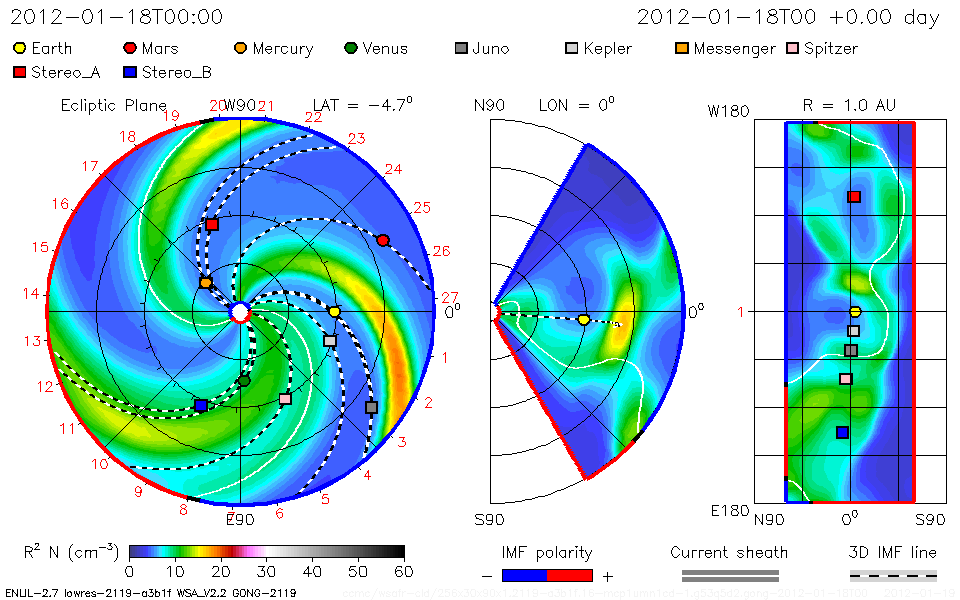Navigation
Install the app
How to install the app on iOS
Follow along with the video below to see how to install our site as a web app on your home screen.

Note: This feature currently requires accessing the site using the built-in Safari browser.
More options
You are using an out of date browser. It may not display this or other websites correctly.
You should upgrade or use an alternative browser.
You should upgrade or use an alternative browser.
Coronal Mass Ejection detected.
- Thread starter Photonic
- Start date
Your link is way to slow a download. SOOOooo... This flare...how big compared to what?
Where is it supposed to cause disruption?
Your link is way to slow a download. SOOOooo... This flare...how big compared to what?
Where is it supposed to cause disruption?
Hmm?
That's because so many people are trying to connect to the link right now.
The graphs show the size.
Does not answer my questions which make all the difference in if we should care.
Photonic
Ad astra!
- Thread starter
- #5
Your link is way to slow a download. SOOOooo... This flare...how big compared to what?
Where is it supposed to cause disruption?
Hmm?
That's because so many people are trying to connect to the link right now.
The graphs show the size.
Does not answer my questions which make all the difference in if we should care.
I included the graphs because they display both the intensity and size of the ejection.
Hmm?
That's because so many people are trying to connect to the link right now.
The graphs show the size.
Does not answer my questions which make all the difference in if we should care.
I included the graphs because they display both the intensity and size of the ejection.
I suspect most if not all here are not astrophysisists. Your graphs mean nothing without something to compare them with and a projected area on our planet that is supposed to get the majority of extra radiation.
Photonic
Ad astra!
- Thread starter
- #7
Does not answer my questions which make all the difference in if we should care.
I included the graphs because they display both the intensity and size of the ejection.
I suspect most if not all here are not astrophysisists. Your graphs mean nothing without something to compare them with and a projected area on our planet that is supposed to get the majority of extra radiation.
Sorry.
It is an M-Class CME. It's very big, and it has a very long duration. It will strike our entire magnetic field, possibly causing disturbances in electronics, satellites, and radio wave emissions. You will be able to hear radio stations from other continents because it will reflect off of our atmosphere for a while.
I included the graphs because they display both the intensity and size of the ejection.
I suspect most if not all here are not astrophysisists. Your graphs mean nothing without something to compare them with and a projected area on our planet that is supposed to get the majority of extra radiation.
Sorry.
It is an M-Class CME. It's very big, and it has a very long duration. It will strike our entire magnetic field, possibly causing disturbances in electronics, satellites, and radio wave emissions. You will be able to hear radio stations from other continents because it will reflect off of our atmosphere for a while.
Interesting. I've never heard of a flare that lasted 24 hours. The worst ones I know of overloaded electrical transmission lines and caused some blackouts but the regions were like in Nova Scotia and vicinity.. Pretty localized. It takes some hellacious radiation to penetrate the whole Van Allen belt. I guess we will find out regardless because there is nothing we can do about it.
Photonic
Ad astra!
- Thread starter
- #9
I suspect most if not all here are not astrophysisists. Your graphs mean nothing without something to compare them with and a projected area on our planet that is supposed to get the majority of extra radiation.
Sorry.
It is an M-Class CME. It's very big, and it has a very long duration. It will strike our entire magnetic field, possibly causing disturbances in electronics, satellites, and radio wave emissions. You will be able to hear radio stations from other continents because it will reflect off of our atmosphere for a while.
Interesting. I've never heard of a flare that lasted 24 hours. The worst ones I know of overloaded electrical transmission lines and caused some blackouts but the regions were like in Nova Scotia and vicinity.. Pretty localized. It takes some hellacious radiation to penetrate the whole Van Allen belt. I guess we will find out regardless because there is nothing we can do about it.
A long time ago, there was a push to re-work our technology to be resistant to such things as EMR Bursts and geomagnetic disruptions. Unfortunately we never followed through with it. There is radiation shielding on most wires but that is used more for insulation.
If a large enough CME happens, it could wipe out our entire infrastructure in a matter of moments.
Old Rocks
Diamond Member
The Carrington event!
http://www.leif.org/research/1859 Storm - Extreme Space Weather.pdf
Abstract. It is generally appreciated that the September 1859 solar–terrestrial disturbance, the first
recognized space weather event, was exceptionally large. How large and how exceptional? To answer
these questions, we compiled rank order lists of the various measures of solar-induced disturbance for
events from 1859 to the present. The parameters considered included: magnetic crochet amplitude,
solar energetic proton fluence (McCracken et al., 2001a), Sun–Earth disturbance transit time, geomagnetic
storm intensity, and low-latitude auroral extent. While the 1859 event has close rivals or superiors
in each of the above categories of space weather activity, it is the only documented event of the last
∼150 years that appears at or near the top of all of the lists. Taken together, the top-ranking events in
each of the disturbance categories comprise a set of benchmarks for extreme space weather activity.
http://www.leif.org/research/1859 Storm - Extreme Space Weather.pdf
Abstract. It is generally appreciated that the September 1859 solar–terrestrial disturbance, the first
recognized space weather event, was exceptionally large. How large and how exceptional? To answer
these questions, we compiled rank order lists of the various measures of solar-induced disturbance for
events from 1859 to the present. The parameters considered included: magnetic crochet amplitude,
solar energetic proton fluence (McCracken et al., 2001a), Sun–Earth disturbance transit time, geomagnetic
storm intensity, and low-latitude auroral extent. While the 1859 event has close rivals or superiors
in each of the above categories of space weather activity, it is the only documented event of the last
∼150 years that appears at or near the top of all of the lists. Taken together, the top-ranking events in
each of the disturbance categories comprise a set of benchmarks for extreme space weather activity.
Granny says, guess dat accounts fer why March was so warm...

Record-breaking solar flare described
June 11 (UPI) -- A NASA space telescope detected the highest-energy light ever measured in an eruption on the sun during a powerful solar blast, the space agency has reported.
Record-breaking solar flare described
June 11 (UPI) -- A NASA space telescope detected the highest-energy light ever measured in an eruption on the sun during a powerful solar blast, the space agency has reported.
The powerful solar flare, observed March 7 by the Fermi Gamma-ray Space Telescope, produced such an outpouring of gamma rays -- a form of light with even greater energy than X-rays -- that the sun briefly became the brightest object in the gamma-ray sky, NASA said Monday.

This image from Fermi's Large Area Telescope (LAT) shows how the entire sky looked on March 7 in the light of high-energy gamma rays. The sun, in the lower part of the image, was the source of the highest-energy rays. Credit: NASA/DOE/Fermi LAT Collaboration
"For most of Fermi's four years in orbit, its LAT saw the sun as a faint, steady gamma-ray source thanks to the impacts of high-speed particles called cosmic rays," Nicola Omodei, an astrophysicist at Stanford University, said. "Now we're beginning to see what the sun itself can do."
The March flare produced high-energy gamma rays for about 20 hours, two and a half times longer than any event on record, researchers said. Solar eruptions are increasing as the sun moves toward the peak of its roughly 11-year-long activity cycle, expected in mid-2013, they said.
Read more: Record-breaking solar flare described - UPI.com
Uncle Ferd got his tin-foil hard hat on so it don't fry his brain an' turn him into a lib'ral...
Double Solar Storms Headed to Earth Raise Disruption Concerns
September 11, 2014 — A rare double burst of magnetically-charged solar storms will hit Earth Thursday night and Friday, raising concerns that GPS signals, radio communications and power transmissions could be disrupted, officials said on Thursday.
Double Solar Storms Headed to Earth Raise Disruption Concerns
September 11, 2014 — A rare double burst of magnetically-charged solar storms will hit Earth Thursday night and Friday, raising concerns that GPS signals, radio communications and power transmissions could be disrupted, officials said on Thursday.
Individually, the storms, known as coronal mass ejections, or CMEs, wouldn't warrant special warnings, but their unusual close timing and direct path toward Earth spurred the National Oceanic and Atmospheric Administration's Space Weather Prediction Center to issue an alert. The first CME, which burst from a magnetically disturbed region of the sun on Monday night, should reach Earth Thursday night, center director Thomas Berger told reporters on a conference call.
The same patch of solar real estate produced a second, more powerful storm about 1:45 p.m. EDT/1745 GMT on Wednesday. “We don't expect any unmanageable impacts to national infrastructure from these solar events at this time, but we are watching these events closely,” Berger said. The sun currently is in the peak of its 11-year cycle, though the overall level of activity is far lower than a typical solar max.

This image provided by NASA, shows an extreme ultra-violet wavelength image of solar flare captured about 1:45 p.m. EDT, Sept. 10, 2014.
Storms as powerful as the ones now making their way toward Earth typically occur 100 to 200 times during a solar cycle, Berger said. “The unique thing about this event is that we've had two in close succession and the CMEs could possibly be interacting on their way to Earth, at the Earth's orbit or beyond. We just don't know that yet,” he said.
The highly-energetic, magnetically-charged solar particles could hit Earth's magnetic field and disrupt some radio communications and degrade GPS signals, NOAA said. The storms also have the potential to impact electric field power grids in the northern latitudes, which are more susceptible to geomagnetic disturbances.
Power grid operators and the Federal Emergency Management Agency (FEMA) have been notified “just in case,” Berger added. On the plus side, the storms should trigger beautiful auroral displays, visible wherever clear skies prevail along the northern tier of the United States. Aurora are caused by electrically-charged solar particles hitting oxygen, nitrogen and other gases high in the atmosphere, creating curtains of light above the planet's magnetic north and south poles.
Double Solar Storms Headed to Earth Raise Disruption Concerns
Granny wonderin' if it has anythin' to do with dem meteors dem space alines been flingin' at us?...
Big solar storm hitting Earth
Fri September 12, 2014 | Strong geomagnetic storm watch has been issued; Storm could impact power grid, satellites; Auroras are possible in northern latitudes
Big solar storm hitting Earth
Fri September 12, 2014 | Strong geomagnetic storm watch has been issued; Storm could impact power grid, satellites; Auroras are possible in northern latitudes
Big storms are hitting Earth, but you don't need a raincoat or umbrella. These storms are coming from the sun. It's raining down a huge amount of solar radiation. We're safe, but power grids, radios and satellites may be affected. Experts say the combined energy from two recent solar events has arrived, prompting the Space Weather Prediction Center to issue a strong geomagnetic storm watch for Saturday. Wait. What's a solar storm? Basically, the sun is a giant ball of gas: 92.1% hydrogen and 7.8% helium. Every now and then, it spits out a giant burst of radiation called a coronal mass ejection.
These ejections are sometimes associated with solar flares, the most explosive events in the solar system. The sun has released two ejections in the past few days, and both are linked to solar flares. NASA says the second flare is an X1.6 class, putting it in the most intense category. The energy from those two ejections is now hitting Earth. Space weather experts aren't sure what this solar storm will do.
Earth's atmosphere usually protects us humans, but you might want to keep a flashlight handy. Solar storms can knock out power, interfere with GPS and radio communications -- including those on commercial airliners -- and damage satellites. "People on the ground really don't have to worry," said Lika Guhathakurta, a program scientist with NASA's Solar Dynamics Observatory. She said solar storms don't affect humans on the ground, although astronauts could be at risk. And our technology.

A mid-level flare erupted on the left side of the sun on July 8, 2014. This image from NASA's Solar Dynamics Observatory highlights the high-temperature solar material in a flare, which is typically colorized in teal.
But don't worry too much. NASA can take steps to protect the crew members on the International Space Station, and satellite operators can turn off sensitive sensors on satellites. Should we be worried the solar storm will fry our smartphones or other gadgets? "No, very unlikely," Dr. Petrus Martens, an expert on solar flares and a professor in the Department of Physics and Astronomy at Georgia State University, told CNN. "Of course if we lose the (power) grid, that will eventually affect cell phones and the Internet as well." Besides power grids and satellites, Martens says other possible impacts are:
• Distortions in GPS readings of up to a few yards. That is not much, but it can be crucial for military applications; for example, targeting by drones.
• Increased corrosion of long pipelines like the Alaska oil pipeline.
• Homing pigeons going off course. (Martens is not joking about that one.)
Solar storms have caused havoc on Earth before. On March 13, 1989, a solar storm knocked out power for the entire province of Quebec for 12 hours. Power grids in the United States were affected but didn't have blackouts. NASA says some satellites tumbled out of control for hours during what's known as the Quebec Blackout. The space shuttle Discovery was in orbit at the time and had a mysterious sensor problem that went away after the storm, NASA says. On the upside, solar storms also create beautiful aurora. Aurora watchers in the northern United States who are outside major metropolitan areas should be watching the skies the next few nights. "A fantastic display of Northern Lights as far south as the northern half of the U.S." is possible, Martens said.
Big solar storm hitting Earth - CNN.com
Mr. H.
Diamond Member
Nice to know Granny and Ferd are still kickin'. 

Mr. H.
Diamond Member
I got kicked out of church once.
It was a Catholic Mass Ejection.
It was a Catholic Mass Ejection.
Similar threads
- Replies
- 7
- Views
- 165
- Replies
- 3
- Views
- 601
- Replies
- 14
- Views
- 287
Latest Discussions
- Replies
- 9K
- Views
- 262K
- Replies
- 6
- Views
- 38
- Replies
- 39
- Views
- 283
- Replies
- 76
- Views
- 637
Forum List
-
-
-
-
-
Political Satire 8005
-
-
-
-
-
-
-
-
-
-
-
-
-
-
-
-
-
-
-
ObamaCare 781
-
-
-
-
-
-
-
-
-
-
-
Member Usernotes 466
-
-
-
-
-
-
-
-
-
-

